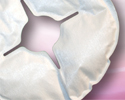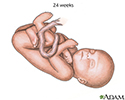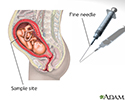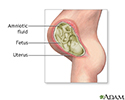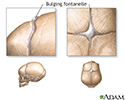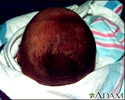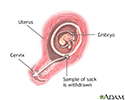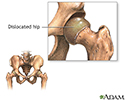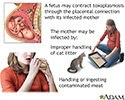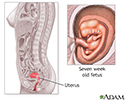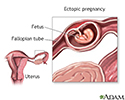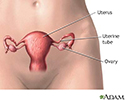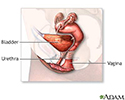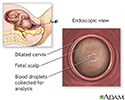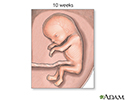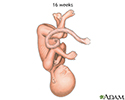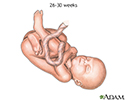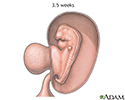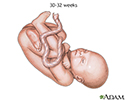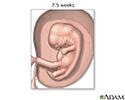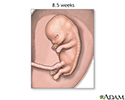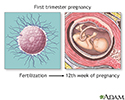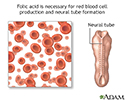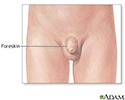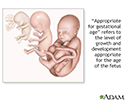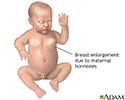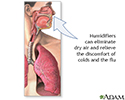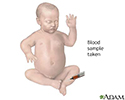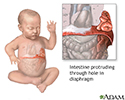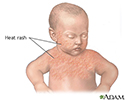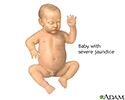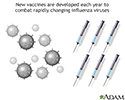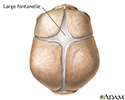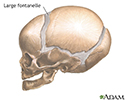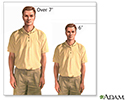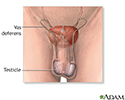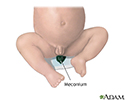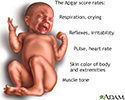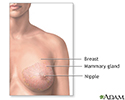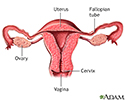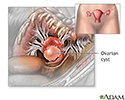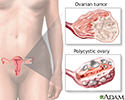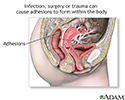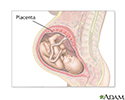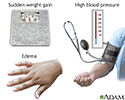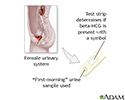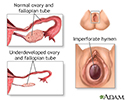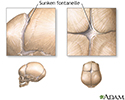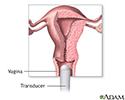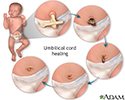Multimedia Gallery
Newborn jaundice
Are your newborn baby's skin or eyes yellow? Is she extremely tired and doesn't want to eat? Your baby may have jaundice.
Newborn jaundice happens when your baby has high levels of bilirubin in her blood. This yellow pigment is created in the body during the normal recycling of old red blood cells. The liver helps break bilirubin down so it can be removed from the body in the stool. Before a baby is born, the placenta removes the bilirubin from your baby so it can be processed by your liver. Right after birth, the baby's own liver takes over the job, but it can take time. Most babies have some jaundice. It usually appears between the second and third day after birth.
Often babies get a screening test in the first 24 hours of life to predict if they are likely to develop jaundice. Your baby's doctor will also watch for signs of jaundice at the hospital, and during follow-up visits after your baby goes home. If your baby seems to have jaundice, the doctor will test the bilirubin levels in her blood.
So, how do you treat newborn jaundice?
Jaundice usually goes away on its own, so treatment is usually not necessary. If your baby's bilirubin level is too high or rising too quickly, however, she may need treatment.
You'll need to keep the baby well hydrated with breast milk or formula. Feeding up to 12 times a day will encourage frequent bowel movements, which help to remove the bilirubin. If your baby needs treatment in the hospital, she may be placed under special blue lights that help break down bilirubin in the baby's skin. This treatment is called phototherapy. If your baby's bilirubin level isn't rising too quickly, you can also do phototherapy at home with a fiberoptic blanket that contains tiny bright lights.
For most babies, it takes about a week or two for jaundice to go away.
Newborn jaundice
Review Date: 4/5/2025
Reviewed By: Charles I. Schwartz, MD, FAAP, Clinical Assistant Professor of Pediatrics, Perelman School of Medicine at the University of Pennsylvania, General Pediatrician at PennCare for Kids, Phoenixville, PA. Also reviewed by David C. Dugdale, MD, Medical Director, Brenda Conaway, Editorial Director, and the A.D.A.M. Editorial team.
Animations
- Breast engorgement
- Cell division
- Cesarean section
- Conception - general
- Conception - pregnancy
- Conception of identical twins
- C-section
- Early labor
- Egg cell production
- Egg production
- Endometriosis
- Fetal ear development
- Formation of twins
- Human face formation
- Infant formulas
- Kids - How big is the baby?
- Kids - How does the baby co...
- Kids - Is it a girl or boy?
- Kids - Umbilical cord
- Kids - Where do babies come...
- Newborn jaundice
- NICU consultants and suppor...
- Ovulation
- Placenta delivery
- Placenta formation
- Preeclampsia
- Pregnancy
- Pregnancy care
- Sperm production
- Sperm release pathway
- Storing breast milk
- The role of amniotic fluid
- Twin-to-twin transfusion sy...
- Ultrasound
- Vaginal delivery
Illustrations
- 24-week fetus
- Abnormal discharge from the...
- Abnormal menstrual periods
- Absence of menstruation (am...
- Amniocentesis
- Amniocentesis
- Amniotic fluid
- Amniotic fluid
- Anatomy of a normal placenta
- Antibodies
- Baby burping position
- Bananas and nausea
- Blood cells
- Blood test
- Breast infection
- Breastfeeding
- Bulging fontanelles
- Candida - fluorescent stain
- Caput succedaneum
- Cesarean section
- Cesarean section
- Cesarean section
- Childbirth
- Chorionic villus sampling
- Congenital hip dislocation
- Congenital toxoplasmosis
- Crying - excessive (0 to 6 ...
- Delivery presentations
- Developmental milestones
- Early weeks of pregnancy
- Ectopic pregnancy
- Emergency Childbirth
- Emergency Childbirth
- Endocrine glands
- Endometriosis
- Endometritis
- Erythroblastosis fetalis - ...
- Female breast
- Female reproductive anatomy
- Female reproductive anatomy
- Female reproductive anatomy...
- Female urinary tract
- Fetal blood testing
- Fetal head molding
- Fetus at 10 weeks
- Fetus at 12 weeks
- Fetus at 16 weeks
- Fetus at 26 to 30 weeks
- Fetus at 3.5 weeks
- Fetus at 30 to 32 weeks
- Fetus at 7.5 weeks
- Fetus at 8.5 weeks
- First trimester of pregnancy
- Folic acid
- Folic acid benefits
- Folic acid source
- Follicle development
- Fontanelles
- Foreskin
- Gestational ages
- Gestational diabetes
- Gonadotropins
- Head circumference
- Heat rash
- Height/weight chart
- Hormonal effects in newborns
- Humidifiers and health
- Hysterectomy
- Infant blood sample
- Infant care following delivery
- Infant diaphragmatic hernia
- Infant heat rash
- Infant intestines
- Infant jaundice
- Infantile reflexes
- Influenza vaccines
- Intraductal papilloma
- Intrauterine transfusion
- Jaundiced infant
- Large fontanelles
- Large fontanelles (lateral view)
- Macrosomia
- Male reproductive anatomy
- Male reproductive anatomy
- Male urinary tract
- Mammary gland
- Meconium
- Morning sickness
- Moro reflex
- Newborn head molding
- Newborn test
- Normal female breast anatomy
- Normal uterine anatomy (cut...
- Ovarian cyst
- Ovarian hypofunction
- Overproductive ovaries
- Pelvic adhesions
- Pelvic laparoscopy
- Placenta
- Placenta
- Placenta
- Placenta previa
- Polyhydramnios
- Preeclampsia
- Pregnancy test
- Primary amenorrhea
- Primary infertility
- Secondary amenorrhea
- Secondary infection
- Side sectional view of fema...
- Single palmar crease
- Skull of a newborn
- Slit-lamp exam
- Sperm
- Stein-Leventhal syndrome
- Sunken fontanelles (superio...
- Tobacco health risks
- Transvaginal ultrasound
- Ultrasound in pregnancy
- Ultrasound, color - normal ...
- Ultrasound, normal fetus - ...
- Ultrasound, normal fetus - ...
- Ultrasound, normal fetus - ...
- Ultrasound, normal fetus - face
- Ultrasound, normal fetus - ...
- Ultrasound, normal fetus - foot
- Ultrasound, normal fetus - ...
- Ultrasound, normal fetus - ...
- Ultrasound, normal fetus - ...
- Ultrasound, normal fetus - ...
- Ultrasound, normal placenta...
- Ultrasound, normal relaxed ...
- Umbilical cord healing
- Uterus
- Vaginal bleeding during pre...
- Well baby visits
- Yeast infections

 Bookmark
Bookmark



























